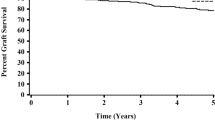Abstract
Background
The utilization of kidney grafts from expanded criteria donors (ECDs) needs to be evaluated within the context of critical organ shortage and graft function and survival. The impact of donor risk variables on kidney transplantation (KTx) outcome was investigated.
Methods
A retrospective review of 75 KTxs from ECDs over a 5-year period was performed. Donor risk factors were analyzed separately and correlated with recipients graft function and survival.
Results
Sixty-four recipients out of 75 (85.3%) had functioning grafts 5 years post-transplant. The overall actuarial graft survival rates at 1 through 5 years were 87.5, 68.1, 57.3, 55.4, and 47.3%, respectively. Forty-seven kidneys (62.7%) had early function with actuarial survival of 100.0, 88.3, 75.8, 75.8, and 68.4% at 1–5 years post-transplant, and 28 (37.3%) grafts presented delayed function with substantially decreased actuarial survival, ranging from 66.7 to 23.2%. KTxs from elderly donors had remarkable actuarial survival rates ranging from 100.0 to 67.0%, at 1–5 years, being the best graft survival rates among KTxs from other donor categories. The other donor risk variables when associated with old age had an adverse effect on recipient graft function and survival, but none alone or a combination of the two, showed any significant statistical variability.
Conclusion
ECDs significantly increased the kidney pool and can be utilized safely if adequate measures are taken.

Similar content being viewed by others
References
Pessione F, Cohen S, Durand D, Hourmant M, Kessler M, Legendre C, Mourad G, Noel C, Peraldi M-N, Pouteil-Noble C, Tuppin P, Hiesse C (2003) Multivariate analysis of donor risk factors for graft survival in kidney transplantation. Transplantation 75:361
Carter JT, Lee CM, Weinstein RJ, Lu AD, Dafoe DC, Alfrey EJ (2000) Evaluation of the older cadaveric kidney donor: the impact of donor hypertension and creatinine clearance on graft performance and survival. Transplantation 70:765
Lopez-Navidad A, Caballero F (2003) Extended criteria for organ acceptance. Strategies for achieving organ safety and for increasing organ pool. Clin Transplant 17:308
Stratta RJ, Rohr MS, Sundberg AK, Armstrong G, Hairston E, Hartmann E, Farney AC, Roskopf J, Iskandar SS, Adams PL (2004) Increased kidney transplantation utilizing expanded criteria donor transplant. Ann Surg 239:688
Kuo PC, Johnson LB, Schweitzer EJ, Alfrey EJ, Waskewitz J, Bartlett ST (1996) Utilization of the older donor for renal transplantation. Am J of Surgery 172:551
Ratner LE, Kraus E, Magnuson T, Bender JS (1996) Transplantation of kidneys from expanded criteria donors. Surgery 119:372
Audard V, Matignon M, Dahan K, Lang P, Grimbert P (2007) Renal transplantation from extended criteria cadaveric donors: problems and perspectives overview. Transpl Int ISSN: 1
Remuzzi G, Cravedi P, Perna A, Dimitrov B, Turturo M, Locatelli G, Rigotti P, Baldan N, Beatini M, Valente U, Scalamogna M, Ruggenenti P (2006) Long-term outcome of renal transplantation from older donors. N Engl J Med 354:343
Lu AD, Desai D, Myers BD, Dafoe DC, Alfrey EJ (2000) Severe glomerular sclerosis is not associated with poor outcome after kidney transplantation. Am J Surg 180:470
Gomez E, Aguado S, Tejada F, Diaz-Corte C, Seco M, Alvarez–Grande J (1995) Successful transplant of kidneys with diffuse diabetic glomerulosclerosis. Transplantation 59:156
Rea R, Smith C, Sandhu K, Kwan J, Tomson C (2001) Successful transplant of a kidney with focal segmental glomeruloslerosis. Nephrol Dial Transplant 16:416
Pokorna E, Vitko S, Chadimova M, Schuck O, Ekberg H (2000) Proportion of glomerulosclerosis in procurement wedge renal biopsy cannot alone discriminate for acceptance of marginal donors. Transplantation 69:36
Rao KV, Kasiske BL, Odlund MD, Ney AL, Anderson RC (1990) Influence of cadaver donor age on posttransplant renal function and graft outcome. Transplantation 49:91
Sautner T, Gotzinger P, Wamser P, Gnant M, Steininger R, Muhlbacher F (1991) Impact of donor age on graft function in 1180 consecutive kidney recipients. Transplant Proc 23:2598
Lloveras J, Arias M, Puig JM et al (1995) Five-year follow up of 250 recipients of cadaveric kidney allografts from donors older than 55 years of age. Transplant Proc 27:981
Hariharan S, McBride MA, Bennett LE, Cohen EP (1997) Risk factors for renal allograft survival from older cadaver donors. Transplantation 64:1748
Sola R, Guirado L, Diaz JM, Lopez-Navidad A, Caballero F, Gich I (2002) Elderly donor kidney grafts into young recipients: results at 5 years. Transplantation 73:1673
Morrissey PE, Gohh R, Yango A, Gautam A, Monaco AP (2004) Renal transplant survival from older donors. Arch Surg 139:384
Ojo AO, Leichtman AB, Punch JD et al (2000) Impact of pre-existing donor hypertension and diabetes mellitus on cadaveric renal transplant outcomes. Am J Kidney Dis 36:153
Di Paolo S, Stallone G, Schena A, Infante B, Gesualdo L, Shena FP (2002) Hypertension is an independent predictor of delayed graft function and worse renal function only in kidneys with chronic pathological lesions. Transplantation 72:623
Ratner LE, Joseph V, Zibari G, Patel S, Maley WR, Kittur D, Burdick J, Olson J (1995) Transplantation of kidneys from hypertensive cadaveric donors. Transplant Proc 27:989
Becker YT, Leverson GE, D’Alessandro AM, Sollinger HW, Becker BN (2002) Diabetic kidneys can safely expand the donor pool. Transplantation 74:141
Author information
Authors and Affiliations
Corresponding author
Rights and permissions
About this article
Cite this article
Karatzas, T., Gompou, A., Bokos, J. et al. Optimal utilization of expanded criteria deceased donors for kidney transplantation. Int Urol Nephrol 43, 1211–1219 (2011). https://doi.org/10.1007/s11255-011-9930-0
Received:
Accepted:
Published:
Issue Date:
DOI: https://doi.org/10.1007/s11255-011-9930-0




